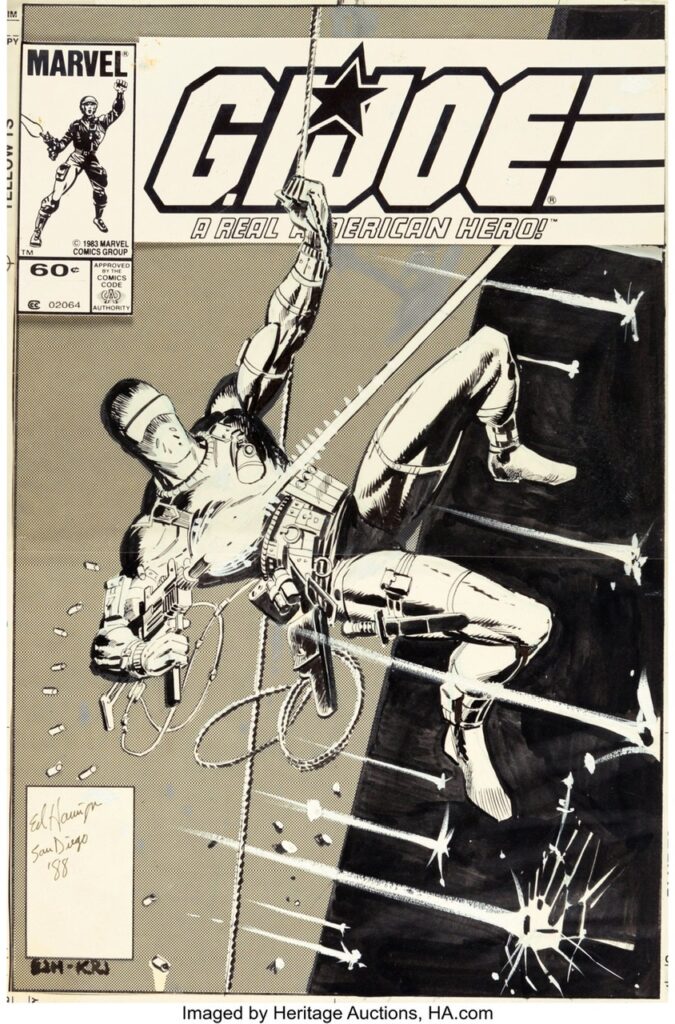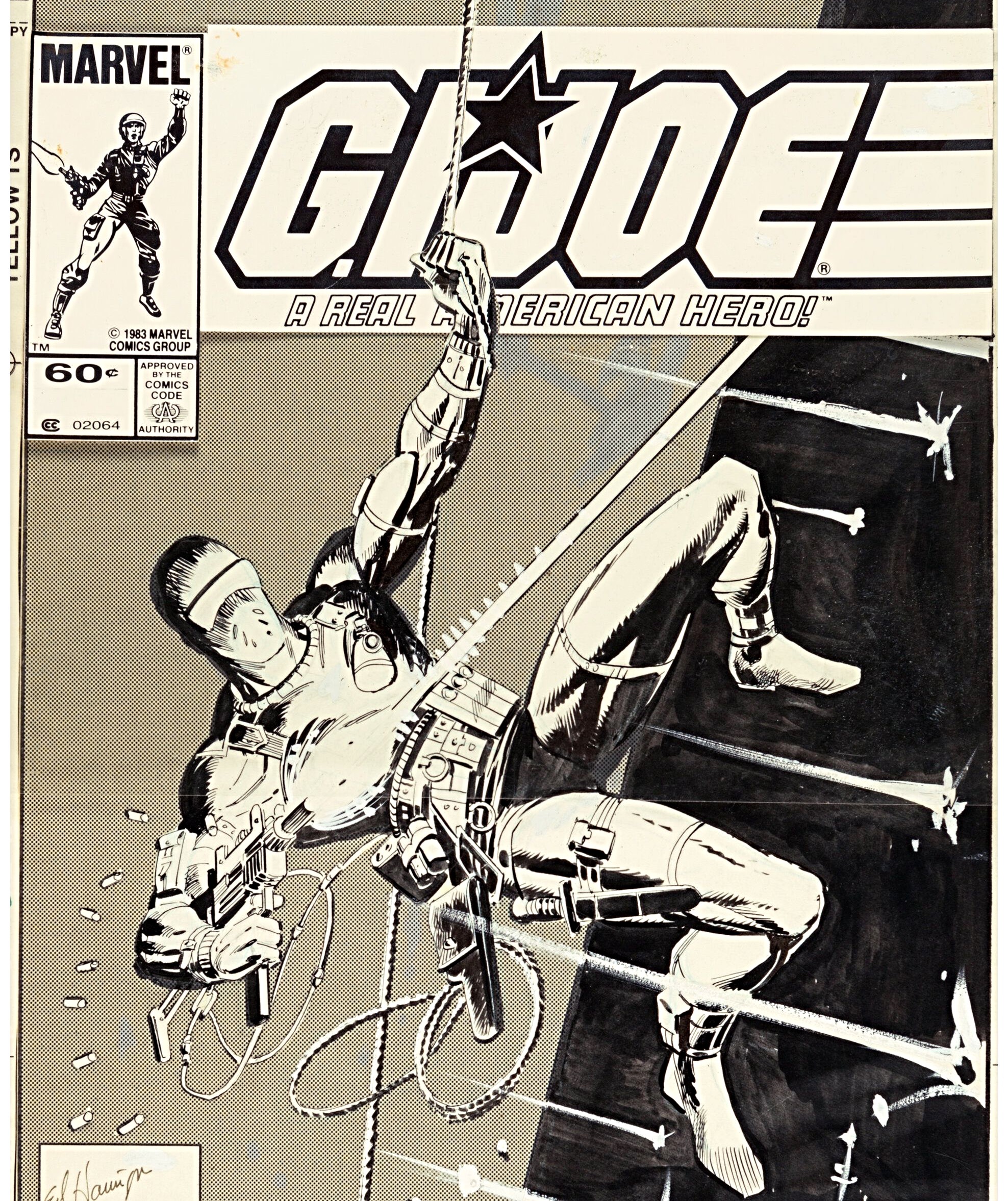*
DALLAS, Texas (Dec. 22, 2021) – It’s the cover to the “silent” comic book that would end up making a lot of noise (history, too).
*
G.I. Joe, A Real American Hero was, for reasons explained below, the first comic book advertised on television. As a result, it became one of Marvel Comics’ top-selling titles of the 1980s: The book survived on spinner racks for more than a decade – unfathomable, then or now, for a toy tie-in. It also spawned one of comicdom’s most famous characters and one of the 1980s’ most coveted covers. G.I. Joe, A Real American Hero No. 21, the first issue to feature ninja commando Snake-Eyes on the cover all by himself.
The original artworkfor that iconic cover, by longtime Marvel and DC artist Ed Hannigan and inker Klaus Janson, crosses the block for the first time next month as one of the centerpiece offerings in Heritage Auctions’ Jan. 13-16 Comics & Comic Art Signature® Auction.
*
The artwork’s consignor, who wishes to remain anonymous, bought the cover in the late 1980s at Talking Illustrations, a comic-book store in New Westminster, British Columbia, that frequently hosted artists’ signings. The shop’s owner often bought pieces from his visiting guests, and would then offer them to customers.
Our consignor picked up the original artwork for the cover to Detective Comics No. 525, with the store’s owner offering to throw in the Hannigan-signed cover to G.I. Joe No. 21 for an extra $150 Canadian. Initially the buyer wasn’t interested, but he ultimately relented: “It looked cool, so I thought, ‘What the hell?’” He framed the Batman cover, which still hangs on an office wall, but stashed the G.I. Joe artwork and a few other pieces in a crawl space … “where it sat for more than 25 years,” says the consignor.
rJust a few months ago he pulled out that envelope to see what was inside, discovering some Green Arrow and Punisherpages along with the Snake-Eyes artwork, at which point he sent the G.I. Joe cover to Heritage Auctions.
Which is how this iconic artwork made its way from a crawl space to the auction block.
*
*
Hannigan was a go-to writer and cover artist beginning in the late 1970s, with a lengthy stint on Marvel’s Defendersbeginning in 1979, followed by his work with writer Bill Mantlo on The Spectacular Spider-Man (for which they created the characters Cloak and Dagger). He eventually moved to DC, where he became best known for his work on Batman books and Mike Grell’s acclaimed Green Arrow series – and for creating the robotic Brainiac in 1983.
From its cover to its interiors, G.I. Joe No. 21 is considered a comic classic – “the most unusual G.I. Joe story ever,” boasts its cover, and “arguably the greatest Joe story ever told,” per the tribute site YoJoe, thanks to a tale told without a single word.
*
Its author was Larry Hama, a U.S. Army veteran who served in Vietnam – and who was Marvel’s author of last resort, as every company writer declined the assignment. As Hama recounted earlier this year in an interview with Looper, G.I. Joewas meant to be his “foot in the door to get writing work,” after a decade of rejection. He had little interest in writing military tales or superhero stories: “I wanted to do funny animals from the get-go.”
But no one was buying what he was selling, so he got the G.I. Joe gig “by accident.” He stuck with the comic as writer and artist throughout its 155-issue run, lasting from 1982 until ’94, during which he helped create Snake-Eyes (and Cobra Commander, Destro, Serpento, Grunt, Zap and …) and eventually served as consultant for 2021’s big-screen iteration Snake Eyes: G.I. Joe Origins.
*

*
“The G.I. Joe fantasy was not as much a military fantasy or a superhero fantasy as it was a fantasy about camaraderie and brotherhood and working together,” Hama said in September. “And that’s the way I saw it. In fact, I’ve said this before, but I’ve always been a Carl Barks Uncle Scrooge fan, and still am. So, in my head, basically G.I. Joe was The Junior Woodchucks with guns.”
*
G.I. Joe No. 21, however, was unlike anything ever seen in the medium – a “Silent Interlude,” as the story was called, that featured Cobra Commander and introduced Storm Shadow and his Arashikage Ninja. So popular was the book that it has been republished numerous times, including in a 30th-anniversary hardback edition from IDW, which called it “the story that defined a generation.”
*
*
Hama once told Comics Interview magazine he merely “wanted to see if I could do a story that was a real, complete story – beginning, middle, end, conflict, characterization, action, solid resolution – without balloons or captions or sound effects.” The result was one of comicdom’s most influential books: “‘Silent Interlude’ is one of the best-written G.I. Joe comics, and possibly one of the best-written Marvel comics,” writer Travis Hedge Coke said in 2014. “It’s practically a masterclass in comics storytelling techniques and application.”
And none of it would have been possible without “America’s movable fighting man.”
*
That’s what Hasbro called G.I. Joe in 1963 to get boys to play with action figures the size of dolls. The slogan worked so well that by 1964 Joe became a comic-book character, his mug and moniker splashed across the covers of two issues of DC Comics’ Showcase that promised “the kind of blockbuster bravery that put the stars and stripes in our flag!”
Yet for 20 years, that was that. Just as suddenly Joe was out of the comic books and back in the box, until the 1980s. That’s when Hasbro’s toy soldiers became action figures who starred in animated television commercials for Marvel comic books that eventually morphed into a cartoon series that later turned into a blockbuster big-screen franchise. Or something like that.
*
So convoluted is G.I. Joe’s journey back to comic books, thanks to a Marvel-Hasbro partnership, that its origin story has been oft-told, from research papers to YouTube histories. One academic even asked of G.I. Joe in 2008: “Was he toy, cartoon, or comic?” Yes. The answer is yes.
Hasbro licensed the character to Marvel to create comics in order to help build and expand a universe of small-scale 3¾-inch action figures action figures mimicking Kenner’s blockbuster Star Wars toys. To skirt FCC rules prohibiting the use of animated ads to sell toys, Hasbro sold the comics (and, wink, the action figures) using animated spots, which played like mini-episodes of a cartoon series. Which explains the genesis of characters who often bore little resemblance to America’s original movable fighting man.
And then there was Snake-Eyes, created by Hama and made comic-book cover star by Hannigan and Janson; all, real American comic-book heroes.
*
Heritage Auctions is the largest fine art and collectibles auction house founded in the United States, and the world’s largest collectibles auctioneer. Heritage maintains offices in New York, Dallas, Beverly Hills, Chicago, Palm Beach, London, Paris, Geneva, Amsterdam and Hong Kong.


